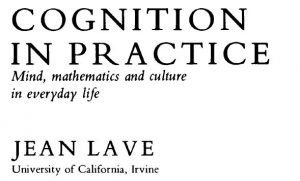Theories et pratiques de l’apprentissage situé 48/101

Cognition in practice 28/n

Cognition in Pactice
Introduction
Dans ce nouvel article sur le livre de Jean Lave « Cognition in Practice » nous revenons sur le concept de « Person-acting » que nous avons traduit par « personne-agissante » ou « personne en action » qui en substance nous dit que la personne est constituée en relation avec d’autres aspects du monde vécu. la séparation entre la personne et ce qui l’entoure n’étant pas aussi nette que l’on pourrait le penser, la limite ne passant pas par la surface de la peau. Les points de vue de Pierre Bourdieu et de Merleau-Ponty sont aussi sollicités.
La personne-agissante (ou personne en action)
La personne est constituée en relation avec d’autres aspect du monde vécu
« I propose to address cognition and culture and their various entailments at different levels of social analysis. Among other things, this requires a broadening of the terms of analysis to reflect the claim that the « person, » including the person thinking, is constituted in relation with other aspects of the lived-in world. »
Un moi incarné est impliqué dans le monde et leurs relations ne sont pas complètement décomposables à des fins analytiques en éléments ainsi impliqués.
An embodied self is entailed with the world and their relations are not completely decomposable for analytic purposes into the elements so entailed.
De plus, le choix du monde vécu et vécu comme un élément de la constitution dialectique de l’ordre socioculturel met l’accent sur la notion que les personnes sont directement engagées dans le monde.
« Further, the choice of the experienced, lived-in world as one element in the dialectical constitution of sociocultural order places emphasis on the notion that persons are directly engaged with the world. This stands in opposition to the pervasive tendency in Western thought to dismiss the significance of active experience in the generation of cognitive processes. Both kinds of involvement of the person with the world – their entailments and direct experience – require further discussion. »
L’affirmation selon laquelle la personne est socialement constituée entre en conflit avec la vision conventionnelle dans sa forme la plus fondamentale, avec la vénérable séparation de l’esprit du corps.
« The claim that the person is socially constituted conflicts with the conventional view in its most fundamental form, with the venerable division of mind from body. For to view the mind as easily and appropriately excised from its social milieu for purposes of study denies the fundamental priority of relatedness among person and setting and activity. »
La stratégie adoptée ici consiste à remplacer les divisions dichotomiques, en particulier entre l’esprit et le corps, par des divisions qui les recoupent et reflètent ce qui semble être des catégories plus fondamentales de l’expérience quotidienne.
« The strategy adopted here is to replace dichotomous divisions, especially between the mind and the body, with ones that cross-cut them and reflect what appear to be more fundamental categories of everyday experience. (However, I am aware that this attempt to make explicit some of the issues in a consistent theory of the person-acting overreaches the limits of the em pirical research and is thus necessarily both sketchy and speculative.) »
La première étape consiste à intégrer le caractère actif de l’expérience dans l’unité d’analyse. L’action de la personne (dans le milieu), en tant qu’unité d’analyse intégrale, est très différente d’une « personne ».
« The first step is to incorporate the active character of experience into the unit of analysis. The person-acting (in setting), as an integral unit of analysis, is quite different from a « person » (Minick 1985). »
Les théories conventionnelles de la personne, conçues séparément de l’activité et du monde de l’objet, peuvent tenir compte de l’activité et du contexte de la personne, mais seulement dans la mesure où ils sont situés à l’intérieur de la personne, comme représentations à consulter (Minick 1985).
« Conventional theories of the person, conceived in separation from activity and the object world, may include consideration of the person’s activity and context, but only as they are located within the person, as representations to be consulted. »
En revanche, dans une théorie de la pratique, le cadre et l’activité se connectent avec l’esprit à travers leurs relations constitutives avec la personne-agissante. De plus, la description d’une personne en action inclut son corps.
« In contrast, in a theory of practice, setting and activity connect with mind through their constitutive relations with the person-acting. Further, a description of a person in action includes the person’s body.
In the Weight Watcher study, for example, self and body are treated as aspects of persons-acting. Both have a social and physical character, and are mutually entailed in one another in multiple and complex ways. »
La personne-agissante et le monde social tels qu’ils sont mutuellement constitués ne sont pas toujours ou pas exactement séparés par la surface du corps.
« The person-acting and social world as mutually constituted are not always or exactly divided by the surface of the body. »
C’est-à-dire que le moi a un caractère historique et contingent, se déployant à travers la création de valeur en action, en relation avec les autres moi, en contexte.
« That is, the self has a historical and contingent character, unfolding through the creation of value in action, in relation with other selves, in setting. Its character is thus a relational one. »
Certaines de ces relations sont constituées de manière interactive plutôt que comme des agencements intérieurs de la personne, et le monde social est partiellement incarné.
Some of those relations are constituted interactively rather than as internal fixtures of the person, and the social world is partially embodied.
Bourdieu a suggéré qu’une grande partie de la base générative de la pratique est inscrite dans la personne sous la forme de dispositions – « sens fait corps » (1977 : 75).
Bourdieu has suggested that much of the generative basis of practice is inscribed in the person in the form of dispositions – « meaning made body »
Merleau-Ponty soutient l’importance conceptuelle du » privilège perspectif « , une reconnaissance que le moi est sans exception incarné, et donc toujours situé dans le monde (Schenck 1985).
« Merleau-Ponty argues the conceptual importance of « perspectival privilege, » a recognition that the self is without exception embodied, and thus always located inthe world. »
Cette caractéristique constante de l’expérience subjective humaine configure la perception du monde en une hiérarchie d’importance et de signification.
« This constant feature of human subjective experience configures perception of the world into a hierarchy of salience and significance. This view implies that priority, perspective and value are continuously and inescapably generated in activity. The « acting self » so constituted has quite different implications for the nature of the activity-in-setting with which it is engaged, than the simultaneously less social and less physical psychologist’s « person » who for the most part merely consults the world as-internalized or constructs it through other persons’ knowledge. »
L’avers du caractère social du corps est le caractère partiellement physique de l’activité cognitive.
« The obverse side of the social character of the body is the partially physical character of cognitive activity. »
Les gens agissent le plus souvent et le plus efficacement dans le monde lorsqu’ils utilisent tous leurs sens incarnés.
« People act most commonly and most effectively in the world when employing all of their embodied senses. « Common sensibilities » as de la Rocha has coined the term, extends the idea of « sense » to include kinesthetic sense, embodied and mentally constructed and reconstituted experience, that is, all active channels in the biographically rich, actively concerted character of experience.«
En guise de conclusion, Jean Lave nous dit:
J’ai décrit plusieurs défis associés à l’esprit et au corps conçus comme des entités distinctes. Il y a les concepts d’un moi relationnel, le corps en tant que construction sociale et partie intégrante du monde social, et la cognition comme partiellement constituée physiquement dans des sensibilités communes. La cognition en action est par nature fusionnée avec le sentiment puisqu’elle ne peut pas être séparée de l’expression et de la création de valeur. Il y a un certain nombre de raisons, semble-t-il, d’abandonner la catégorisation du savoir, de la pensée et de l’esprit. le sentiment à l’image d’une personne et d’un monde rigoureusement séparé.
« I have described several related challenges to mind and body conceived as separate entities. There are the concepts of a relational self, the body as socially constructed and part of the social world, and cognition as partially physically constituted in common sensibilities. Cognition in action is by nature fused with feeling since it cannot be separated from the expression and creation of value. There are a number of reasons, it seems, to give up categorizing knowledge, thinking and feeling in the image of a person and world stringently divided. »
Traduit avec www.DeepL.com/Translator
Billets précédents
Billet 1: Définitions de l’apprentissage situé
Billet 2: Pourquoi s’intéresser à la théorie de l’apprentissage situé?
Billet 3: Démarche et retour aux sources
Billet 4: Mai 1968 et l’apprentissage situé
Billet 5: Apprentissage situé et conversation
Billet 6: Lucy Suchman, mon téléphone portable et moi
Billet 7: Conversations avec moi-même (n° 1)
Billet 8: L’apprentissage situé mis en pratique, cela ferait quoi?
Billet 9: Contribution de la psychologie soviétique à la théorie de l’apprentissage situé
Billet 10: Les apports de la philosophie à la théorie de l’apprentissage situé
Billet 11: Focus sur l’école Dewey
Billet 12: Apports de la psychologie de la perception – la notion d’affordance
Billet 13: Apprentissage situé et intelligence artificielle, deep learning, réalité virtuelle, réalité augmentée, etc…
Billet 14: Conversations avec moi-même (N°2)
Billet 15: Quand John Dewey rencontre Jean Lave
Billet 16: Cognition in Practice (1/n)
Billet 17: Cognition in Practice (2/n)
Billet 18: Cognition in Practice (3/n)
Billet 19: Cognition in Practice (4/n)
Billet 20 : Cognition in Practice (5/n)
Billet 21: « Conversations avec moi même N°3 »
Billet 22: Cognition in Practice (6/n)
Billet 23: Cognition in Practice (7/n)
Billet 24: Cognition in Practice (8/n)
Billet 25: Cognition in Practice (9/n)
Billet 26: Cognition in Practice (10/n)
Billet 27: Cognition in Practice (11/n)
Billet 28: « Conversations avec moi-même N°4 »
Billet 29: Cognition in Practice (12/n)
Billet 30: Cognition in Practice (13/n)
Billet 31: Cognition in Practice (14/n)
Billet 32: Cognition in Practice (15/n)
Billet 33: Cognition in Practice (16/n)
Billet 34: Cognition in Practice (17/n)
Billet 35: « Conversations avec moi-même N°5 »
Billet 36: Cognition in Practice (18/n)
Billet 37: Cognition in Practice (19/n)
Billet 38: Cognition in Practice (20/n)
Billet 39: Cognition in Practice (21/n)
Billet 40: Cognition in Practice (22/n)
Billet 41: Cognition in Practice (23/n)
Billet 42: « Conversations avec moi-même N°6 »
Billet 43: Cognition in Practice (24/n)
Billet 44: Cognition in Practice (25/n)
Billet 45: Cognition in Practice (26/n)
Related Posts
Le « Team Learning » et les nouvelles situations d’apprentissage l’apport de deux méthodes pédagogiques : la classe inversée et l’apprentissage par problème
Théories et pratiques de l’apprentissage situé 23/101
Théories et Pratiques de l’apprentissage situé 65/101
Articles récents
Archives
- mars 2024
- janvier 2024
- décembre 2023
- septembre 2023
- juin 2023
- avril 2023
- mars 2023
- janvier 2023
- octobre 2022
- septembre 2022
- juillet 2022
- mai 2022
- avril 2022
- mars 2022
- février 2022
- janvier 2022
- octobre 2021
- août 2021
- juillet 2021
- mai 2021
- février 2021
- juin 2020
- mai 2020
- avril 2020
- février 2020
- janvier 2020
- décembre 2019
- novembre 2019
- octobre 2019
- septembre 2019
- août 2019
- juillet 2019
- mai 2019
- avril 2019
- mars 2019
- février 2019
- janvier 2019
- décembre 2018
- septembre 2018
- août 2018
- juillet 2018
- juin 2018
- mai 2018
- avril 2018
- mars 2018
- février 2018
- janvier 2018
- décembre 2017
- novembre 2017
- octobre 2017
- septembre 2017
- août 2017
- juin 2017
- mai 2017
- avril 2017
- mars 2017
- février 2017
- janvier 2017
Catégories
- Actualités
- Adaptive Learning
- Allemagne
- Apprendre
- Apprentissage
- Branding
- Business
- Coaching
- Codeveloppement
- Communautés de pratique
- Deep learning
- Design
- Development
- E-Learning
- Ecole
- Education
- Europe
- Formation
- IA
- Intelligence articificielle
- LBC
- metacognition
- Non classé
- Orientation
- orientation
- Philosophie
- Poésie
- Réalité Augmentée
- Réalité Virtuelle
- Transition digitale
- WOL




Commentaires récents